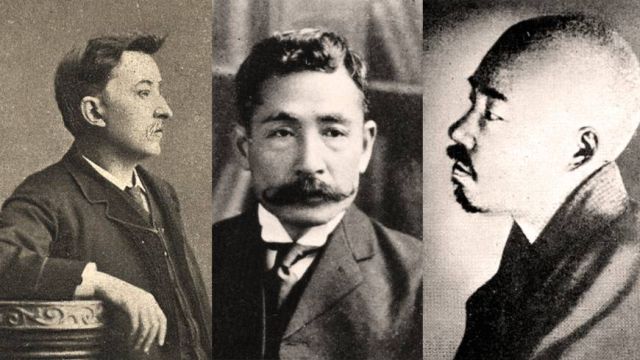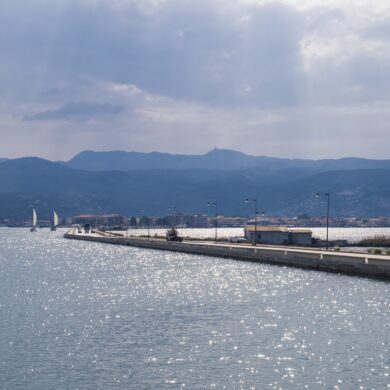By Damian Flanagan
Fascination twinned with veneration of Soseki is exceptionally high in Japan. The Asahi newspaper has been serializing installments of his novels on a daily basis for several years, while a new Soseki museum is scheduled to open next year in the Tokyo district of Shinjuku, where the writer once lived. On television, meanwhile, a drama series titled “Soseki’s Wife” has attempted to show the revered author from his spouse’s perspective.
By a considerable margin, Soseki is the most analyzed Japanese author in modern literature. Hundreds upon hundreds of books have been written about him and thousands upon thousands of academic papers published.
Often regarded as one of the country’s representative “national authors” — a man whose face adorned the ¥1,000 note between 1984 and 2004, and whose works have been a staple of school textbooks for decades — Soseki has come to symbolize Japan’s past struggles with modernization and Westernization. Under intense government pressure to become Japan’s preeminent expert in English literature and imbued with a self-defined mission to produce a revolutionary “theory of literature,” Soseki succumbed to paranoia and anxiety in his mid to late 30s. He later wrote that the entire Japanese nation was being forced into the collective equivalent of a nervous breakdown by having to assimilate several centuries of Western civilization in the course of a few short decades.
Yet certain aspects of Soseki’s writings remain enigmatic. Why, for example, was Soseki so obsessed with the relationship between fine art and literature that he incorporated visual images or ideas taken from paintings into his early novels, but then suddenly stopped doing so mid-career? Or how can we explain a shift halfway through Soseki’s writing career — from “And Then” (1909) onwards — to write novels about “love triangles” when Soseki himself was — as far as we know — never involved in such a relationship?
Or perhaps there is the greatest mystery of all: Why was it that this most naturally gifted writer hardly wrote a word of fiction before suddenly surging into activity at the age of 37 in 1904?
These questions continued to rattle around in my mind until they began to congeal into a new theory.
In autumn last year, I was asked to speak about Lafcadio Hearn (1850-1904), who was a lecturer in English literature at Tokyo Imperial University. Hearn was dismissed from the university in 1903 to make way for Soseki after the Japanese writer’s return from two years of study in Britain, a decision that was met with resentment by Hearn’s devoted students.
Hearn had arrived in Japan in 1890 as the culmination of a worldwide odyssey, and stayed for 14 years until his death in 1904. He set about explaining, in book after book, this mysterious land called “Japan” to readers in the West. Hearn believed he could capture the hidden kokoro (heart) of the Japanese by carefully scrutinizing the world around him. He also discovered that he could probe into the recesses of his own psyche in this “otherworldliness.”
At the same time as Hearn was lecturing English literature at Tokyo Imperial University, a certain Natsume Kinnosuke (later to become “Soseki”) left Japan in 1900 on an odyssey to the West. Soseki, steeped in English literature and nurturing a particular love of 18th-century satirists such as Jonathan Swift and Laurence Sterne, described himself in London in Brobdingnagian terms. He was a sluggish “Tom Thumb” wandering lost in a foggy land of fast-moving giants. In the park, women approached him in their elaborate headdresses like “horned lionesses.”
In “The Tower of London” (1905), Soseki wrote that his first days in London were like depositing a rabbit from Gotemba, at the foothills of Mount Fuji, into the middle of Nihonbashi in the center of Tokyo. The alienation that Soseki initially experienced in London allowed him to view both himself and Japanese society in general with fresh eyes, and he would soon employ Swiftian satire in the depiction of Japan itself.
When Soseki returned to Japan and exploded into prolific writing activity, his first perspective was not that of a rabbit, but of a cat, observing the foibles of Japanese society from a distance. Having replaced Hearn as lecturer at Tokyo Imperial University, Soseki then began implicitly satirizing Hearn’s writings in his own works. Hearn’s strain of sympathetic “cultural anthropology” may have helped to break down walls and introduce “mysterious Japan” to readers in the West, but it also had the feel of an enthusiastic naturalist observing a curious breed of animals.
In “I Am a Cat” (1905-06), Soseki turned all of this on its head and attributed the observations to a small animal. Interestingly, unlike Hearn’s attempts to understand Japan, Soseki wrote very little about his time in England and felt no compulsion to analyze either Britain or the British. His few writings about England are far more about himself than they are any attempt to objectively describe the world around him. This difference in attitude between Soseki and Hearn was based not just on a personality difference, but on Soseki’s profound contemplation of the true nature of literature itself.
Soseki rejected the idea that a writer — or indeed a painter — was someone who depicted the world around them. Rather, he believed that an artist was someone who depicted a reflection of the world that had been transformed by the mirror of their own internal consciousness.
Much has been written about Soseki’s unpleasant experiences in the West. However, was his partial rejection of the West caused by various cultural barriers separating Japan and European nations at the time? Most historians suggest this was the case, and yet I suspect that the “wall” that prevented Soseki from writing until his late 30s was not cultural by nature. Instead, Soseki struggled with the very concept of art itself.
Soseki labored as a relatively obscure academic in the shadow of his contemporary and closest friend, Masaoka Shiki (1867-1902), a renowned writer of haiku.
Soseki was in thrall to Shiki’s haiku composition and, under his influence, sent hundreds of haiku to his friend. When it came to writing haiku, however, it was rather like the literary equivalent of the film “Amadeus,” with Soseki playing the role of Antonio Salieri to Shiki’s Mozart. Like Salieri, Soseki was a highly competent artist but, when it came to haiku, he could never match Shiki’s genius.
Shiki was not much of a literary theorist but, influenced by the painter Nakamura Fusetsu, advocated an agenda of “sketching from life,” which encouraged artists to sweep away old conventions and depict the actual world around you. Like a planet revolving around Shiki’s sun, Soseki was badgered by Shiki to write prose that adhered to this principle. However, Soseki possessed a far more complex, interiorized sensibility than Shiki and, although he may not have realized it, “sketching from life” simply did not suit him.
Ultimately, several things happened that helped Soseki break through that artistic wall. First, Shiki died when Soseki was in London in 1902. Second, Soseki intellectually dismantled Shiki’s simplistic theories with the publication of his forward-thinking “Theory of Literature” (1907). Third, Soseki employed Swiftian satire to overturn the “sketching from life” agendas of both Shiki and Hearn.
The complex feelings that Soseki felt toward Shiki — possessing a sense of love toward him while at the same time secretly nurturing a resentment of being imprisoned by his artistic genius — are perhaps for me the primary reason why Soseki’s later works are dominated by the idea of one man betraying a close friend and being haunted by feelings of guilt. Indeed, the “love triangles” in Soseki’s novels have, in my opinion, little to do with actual women in his life — Soseki was, in fact, rather uninterested in women in his personal life — but everything to do with his battle over art.
Yet Soseki himself — one of the greatest analysts of the human condition — never appears to analyze this cocktail of love and resentment felt toward Shiki within himself. Instead, he transfers his intense feelings of frustration toward a safe, external concept: the West and “English literature.”
Soseki claims he felt oppressed by English literature and that the two years he spent in London were some of the unhappiest in his life. With this in mind, some believe that Soseki would have immersed himself more deeply in the world of haiku had he not been oppressed by his time in England.
To me, however, this appears to be an inversion of reality. Indeed, it could be argued that English literature and the two years he spent in London actually liberated Soseki from the oppressive influence of his beloved friend, Shiki. Without English literature and those “hypocritical” British, Soseki might well have spent the remainder of his life as a Shiki-satellite, producing minor, forgettable haiku. Instead, the satire of 18th-century English literature — that of Swift and Sterne — placed in Soseki’s hands a weapon that helped him smash down the artistic wall that imprisoned him and release his artistic genius.
However, it was too painful for Soseki — too injurious to the love he felt for Shiki — to admit that it was his very best friend who had artistically oppressed him. So instead his venom was turned on Britain and the West.
The perceived barrier between Japan and the outside world is very often a handy means for people in the postwar era to transfer the frustrations and contradictions they feel about completely different matters. Indeed, Yukio Mishima is an obvious example of such at work.
Therefore, it is important not to take the comments of artists about such matters at face value. Instead, it’s necessary to examine whether an artist has ever used the disjuncture between Japan and the outside world as a means of covering up something more painful in their own psyche.
Unfortunately, I don’t have the space here to explain in detail how Soseki proceeded to dismantle Shiki’s legacy in work after work, but I would like to return to the subject of how Soseki dismantled the idea that writers such as Hearn could understand the Japanese through close scrutiny of their outward habits and appearances.
In 1895, Hearn published a book called “Kokoro.” Nineteen years later, his successor at Tokyo Imperial University, Soseki, published a novel of the same title. It’s generally thought that these two books are unrelated, but I believe they are. Indeed, Soseki’s novel could be seen as a satirical inversion of Hearn’s book.
Hearn had argued that the “heart” of the Japanese could be grasped through his “life sketching” techniques, but Soseki demonstrates the reverse. If someone wishes to keep a secret, Soseki would argue, you can never discern it unless that person tells you. In Soseki’s “Kokoro,” Sensei’s wife, Shizu, never learns from her husband the true cause of the death of someone identified only as “K.” Nor would the narrator, a younger man known only as Watashi, understand the hidden secret of Sensei if the older man had not explicitly written down his life story for him.
The human heart or psyche in other words can be impenetrable. This is nothing to do with what an Orientalist of the day may have called “the mysterious Japanese,” but is a universal constant of the human condition. In fact, when Soseki wrote “Kokoro,” he was greatly influenced by William Shakespeare’s “The Merchant of Venice,” which similarly concerns an older man’s desire to plant his memory in a younger man’s heart.
Soseki argues that a novel’s potential for accessing and analyzing the interior thoughts of a character offers writers a means of probing the human psyche. In other words, the most significant barrier is not, as Hearn once believed, any form of cultural wall between Japan and the rest of the world, but the wall that existed between the psyche of one individual and the people around them.
This is the implicit meaning of Soseki’s novel and yet on a personal level Soseki never himself analyzed the wall that divided him from the people around him. Instead, he was arguably happy to play along with the convenient narrative that he was oppressed by the wall that existed between Japan and the West.
In “Kokoro,” the self-indulgent character known as Sensei claims he feels obligated to follow the example of Gen. Nogi Maresuke, who committed ritual suicide on the day of Emperor Meiji’s funeral. In fact, Sensei’s true purpose is arguably much more aggressive: He wishes to use his suicide to seize the heart of the narrator in the same way that “K” had previously seized his heart. In other words, he uses an external fiction to conceal a powerful, unspeakable homoerotic impulse. This deliberate manipulation of external reality as a cover for turbulent inner motives would arguably reflect what Soseki himself did in his own life.
Does anyone believe that Soseki has ultimately concealed the truth about himself? I would go so far as to say that he did so all the time — we all do rather than face the truth about ourselves. It is the outside world that is at fault, we like to tell ourselves: These walls stop us from being our true selves.
At other times, however, the walls that prevent us from communicating with those immediately around us are protective in nature, ensuring that our own psyche is safe. They feed our imagination, make us externalize our fears and, sometimes, help us create timeless art as a result.




